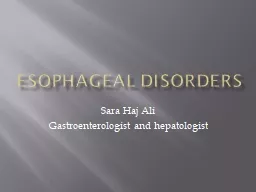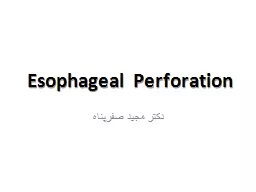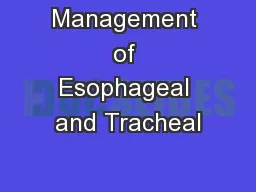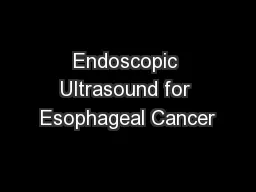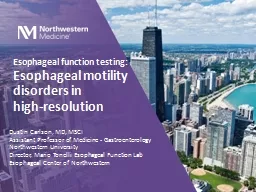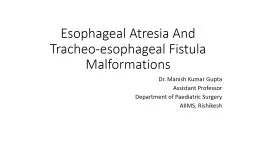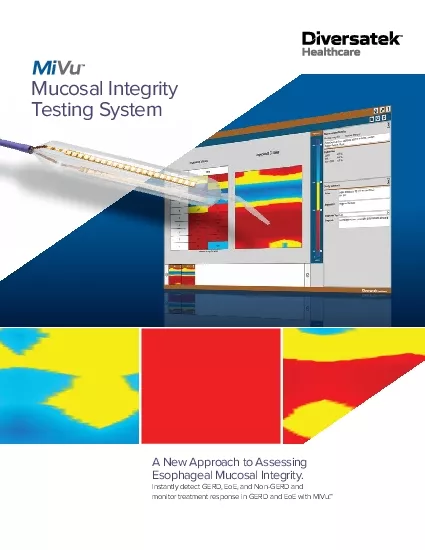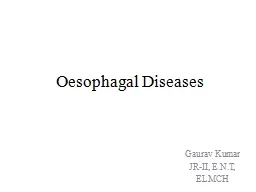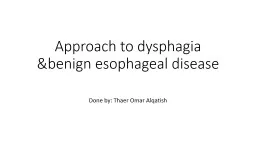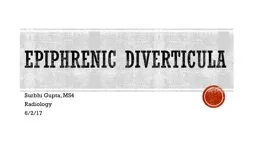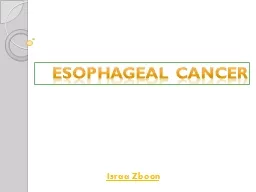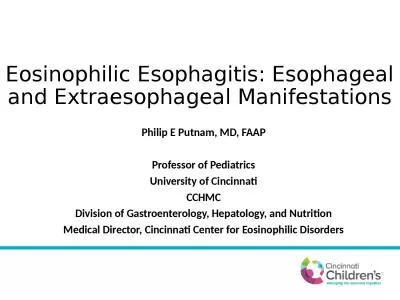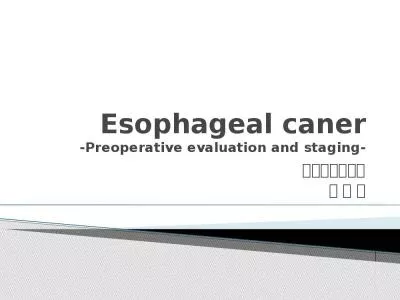PPT-esophageal Disorders Sara Haj Ali
Author : evans | Published Date : 2022-06-11
Gastroenterologist and hepatologist Anatomy Upper sphincter Lower sphincter Gastric Cardia Oesophageal body Diaphragm Symptoms of esophageal d isorders Dysphagia
Presentation Embed Code
Download Presentation
Download Presentation The PPT/PDF document "esophageal Disorders Sara Haj Ali" is the property of its rightful owner. Permission is granted to download and print the materials on this website for personal, non-commercial use only, and to display it on your personal computer provided you do not modify the materials and that you retain all copyright notices contained in the materials. By downloading content from our website, you accept the terms of this agreement.
esophageal Disorders Sara Haj Ali: Transcript
Gastroenterologist and hepatologist Anatomy Upper sphincter Lower sphincter Gastric Cardia Oesophageal body Diaphragm Symptoms of esophageal d isorders Dysphagia Odynophagia Non cardiac chest . Saartjie. . Baartman. . The Venus Hottentot . By Christina Schoenwandt. From Birth…. Born in (approximately) 1789 and lived until 1815. Born to the . Khoikhoi . Tribe of South Africa, near the . Gamtoos. دکتر مجید صفرپناه. Esophageal perforation . is an uncommon occurrence. This is fortunate, as it is a . surgical emergency . that is often difficult to manage, and has devastating . sequelae. Issues. Md.Shadan. . Zeb. Khan. Senior Divisional Security Commissioner/RPF. Ai . naam. -e-. T. u. k . behtreen. . sar. . aghaaz. Bee . naam. -e-. Tu. . naama. . kai. . kunam. . baaz. Phases in . . obstruction by stenting. By. Prof . Khaled. KARARA. Prof of Cardiothoracic Surgery . Alexandria Faculty of Medicine . > 50% of . Oesophageal. . tumours. are inoperable at time of diagnosis.. Amy Schindler. 10/18/10. Esophageal cancer. Diagnosing esophageal cancer. Endoscopic appearance:. Early cancers: superficial plaque, nodule, or ulceration. Advanced lesions: strictures, ulcerated masses, circumferential masses, or large ulcerations. Esophageal . motility . disorders in . high-resolution. Dustin . Carlson, MD, MSCI. Assistant Professor of Medicine - Gastroenterology. Northwestern . University. Director, Mario Tonelli Esophageal Function Lab. Tracheo-esophageal. Fistula Malformations. Dr.. Manish Kumar Gupta. Assistant Professor. Department of Paediatric Surgery. AIIMS, Rishikesh. . Introduction. Embryology. Epidemiology. Associated anomalies. Symptoms Suspicious of Re31ux DiseaseTypical SymptomsAlarm SymptomsResponse to Empiric PPI TherapyRe31ux EvidenceResponse to Antire31ux TherapyResponse to Empiric PPI TherapyNo Re31ux EvidenceEndoscop ACG define – Symptoms or mucosal damage produced by the abnormal reflux of gastric contents into the esophagus which are Often chronic and relapsing.. Pathophysiology. Clinical Presentations of GERD. disease. Done by: Thaer Omar Alqatish. Definitions:. . Dysphagia . ?. . Aphagia. . ?. Odynophagia . ?. Phagophobia. . ?. Classifications for . dysphagia. . 1-. . Oral and Pharyngeal (Oropharyngeal) . Radiology. 6/2/17. Background. DAS, 57 year old female. History of COPD. , . DMII, coronary . artery . disease, now presenting with shortness . of . breath, fever, and cough. Initial . ddx. AND WORKUP. . Zboon. Out lines . Anatomy and . histology of esophagus. Incidence and . prevalence of . esophageal cancer . Types of esophageal cancer . Clinical . picture. Approach. Carcinoma of the esophagus . Extraesophageal. Manifestations. Philip E Putnam, MD, FAAP. Professor . of Pediatrics. University of Cincinnati. CCHMC. Division of Gastroenterology, Hepatology, and Nutrition. Medical Director, Cincinnati Center for Eosinophilic Disorders. 서울대학교병원. 강 창 현. NCCN ESOPH-1. NCCN ESOPH-2. Risk assessment. Age . Functional status. Cardiac function. Respiratory function. Nutritional status. Socioeconomic status. Other treatment options .
Download Document
Here is the link to download the presentation.
"esophageal Disorders Sara Haj Ali"The content belongs to its owner. You may download and print it for personal use, without modification, and keep all copyright notices. By downloading, you agree to these terms.
Related Documents

